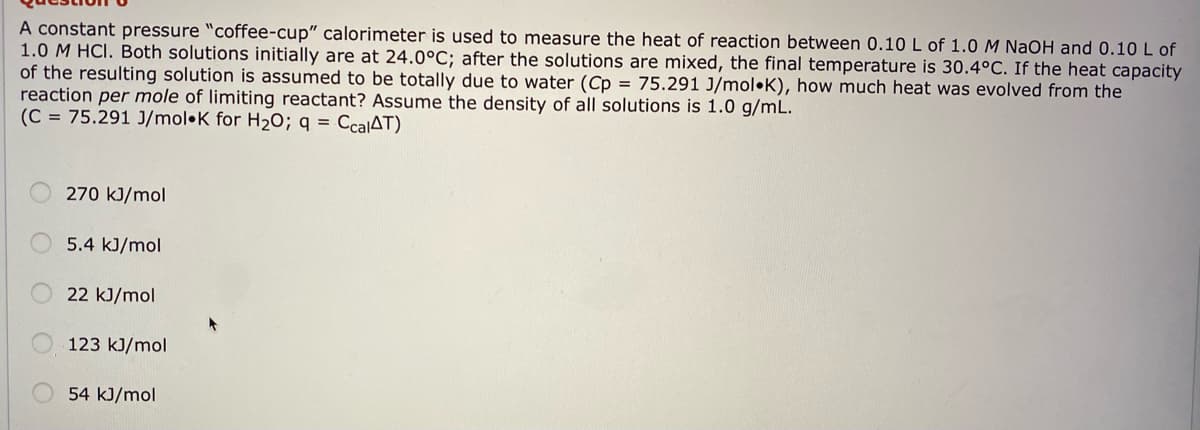A constant pressure "coffee-cup" calorimeter is used to measure the heat of reaction between 0.10 L of 1.0 M NaOH and 0.10 L of 1.0 M HCI. Both solutions initially are at 24.0°C; after the solutions are mixed, the final temperature is 30.4°C. If the heat capacity of the resulting solution is assumed to be totally due to water (Cp = 75.291 J/mol•K), how much heat was evolved from the reaction per mole of limiting reactant? Assume the density of all solutions is 1.0 g/mL. (C = 75.291 J/mol•K for H20; q = CcalAT) 270 kJ/mol 5.4 kJ/mol 22 kJ/mol 123 kJ/mol 54 kJ/mol
A constant pressure "coffee-cup" calorimeter is used to measure the heat of reaction between 0.10 L of 1.0 M NaOH and 0.10 L of 1.0 M HCI. Both solutions initially are at 24.0°C; after the solutions are mixed, the final temperature is 30.4°C. If the heat capacity of the resulting solution is assumed to be totally due to water (Cp = 75.291 J/mol•K), how much heat was evolved from the reaction per mole of limiting reactant? Assume the density of all solutions is 1.0 g/mL. (C = 75.291 J/mol•K for H20; q = CcalAT) 270 kJ/mol 5.4 kJ/mol 22 kJ/mol 123 kJ/mol 54 kJ/mol
Chemistry: An Atoms First Approach
2nd Edition
ISBN:9781305079243
Author:Steven S. Zumdahl, Susan A. Zumdahl
Publisher:Steven S. Zumdahl, Susan A. Zumdahl
Chapter7: Chemical Energy
Section: Chapter Questions
Problem 59E: In a coffee-cup calorimeter, 50.0 mL of 0.100 M AgNO3 and 50.0 mL of 0.100 M HCl are mixed to yield...
Related questions
Question
6

Transcribed Image Text:A constant pressure "coffee-cup" calorimeter is used to measure the heat of reaction between 0.10 L of 1.0 M NaOH and 0.10 L of
1.0 M HCI. Both solutions initially are at 24.0°C; after the solutions are mixed, the final temperature is 30.4°C. If the heat capacity
of the resulting solution is assumed to be totally due to water (Cp = 75.291 J/mol•K), how much heat was evolved from the
reaction per mole of limiting reactant? Assume the density of all solutions is 1.0 g/mL.
(C = 75.291 J/mol•K for H2O; q = CcalAT)
270 kJ/mol
5.4 kJ/mol
22 kJ/mol
123 kJ/mol
54 kJ/mol
Expert Solution
This question has been solved!
Explore an expertly crafted, step-by-step solution for a thorough understanding of key concepts.
This is a popular solution!
Trending now
This is a popular solution!
Step by step
Solved in 2 steps with 2 images

Knowledge Booster
Learn more about
Need a deep-dive on the concept behind this application? Look no further. Learn more about this topic, chemistry and related others by exploring similar questions and additional content below.Recommended textbooks for you

Chemistry: An Atoms First Approach
Chemistry
ISBN:
9781305079243
Author:
Steven S. Zumdahl, Susan A. Zumdahl
Publisher:
Cengage Learning

General Chemistry - Standalone book (MindTap Cour…
Chemistry
ISBN:
9781305580343
Author:
Steven D. Gammon, Ebbing, Darrell Ebbing, Steven D., Darrell; Gammon, Darrell Ebbing; Steven D. Gammon, Darrell D.; Gammon, Ebbing; Steven D. Gammon; Darrell
Publisher:
Cengage Learning

Chemistry by OpenStax (2015-05-04)
Chemistry
ISBN:
9781938168390
Author:
Klaus Theopold, Richard H Langley, Paul Flowers, William R. Robinson, Mark Blaser
Publisher:
OpenStax

Chemistry: An Atoms First Approach
Chemistry
ISBN:
9781305079243
Author:
Steven S. Zumdahl, Susan A. Zumdahl
Publisher:
Cengage Learning

General Chemistry - Standalone book (MindTap Cour…
Chemistry
ISBN:
9781305580343
Author:
Steven D. Gammon, Ebbing, Darrell Ebbing, Steven D., Darrell; Gammon, Darrell Ebbing; Steven D. Gammon, Darrell D.; Gammon, Ebbing; Steven D. Gammon; Darrell
Publisher:
Cengage Learning

Chemistry by OpenStax (2015-05-04)
Chemistry
ISBN:
9781938168390
Author:
Klaus Theopold, Richard H Langley, Paul Flowers, William R. Robinson, Mark Blaser
Publisher:
OpenStax

Chemistry
Chemistry
ISBN:
9781305957404
Author:
Steven S. Zumdahl, Susan A. Zumdahl, Donald J. DeCoste
Publisher:
Cengage Learning


Chemistry & Chemical Reactivity
Chemistry
ISBN:
9781337399074
Author:
John C. Kotz, Paul M. Treichel, John Townsend, David Treichel
Publisher:
Cengage Learning